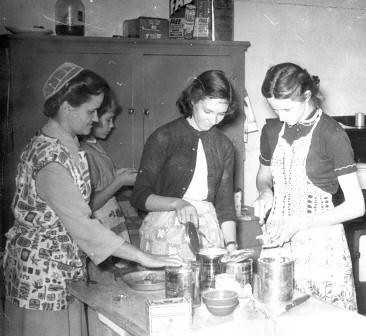Should Home Ec Class Make a Come Back?

April 15, 2019
Home economics, in its basest form, was a course on how to manage being an independent person. I say “was” because, while home economics is now referred to as Family and Consumer Sciences, the fields are not implemented the same in the modern day. Between working households that don’t lend themselves to parents educating kids on things like cooking or taxes and the lack of real-life knowledge being passed down, it’s no wonder that this generation of young adults is characterized by confusion and ignorance. The school system is so focused on testing scores and college applications—which, granted, are important—that areas outside of reading and math have become a lower priority. The question becomes when did real life fall below academics, and why?
Home economics started out in the 1900s to train women for traditional gender roles and to professionalize “women’s work”—domestic tasks like cooking or child care—to raise it in the view of a patriarchal society. However, as gender roles changed and the class remained, people couldn’t get past the stereotype of girls taking home ec to learn to cook while boys tried to keep all their fingers in shop class. The title “home economics” also became more and more inaccurate as the field itself expanded, branching out to include specializations: foods and nutrition in conjunction with food science, child/human development and family relations, textiles/textile science and merchandising consumer goods, interior design with emphasis on wellbeing, consumer economics, and family resource management.
“Home economics” as a name held connotations that were too outdated and too simplistic for the modern version. Thus, the name was changed to “family and consumer sciences” or “human sciences” in 1993 at a conference held in Scottsdale, Arizona. According to the American Association of Family & Consumer Sciences (AAFCS), the field represents “personal finance, nutrition, parenting and childcare, interpersonal relationships, family systems, career exploration and preparation, family resource management, design and merchandising, interior design, the apparel industry, and environmentally responsible construction.”
However, family and consumer sciences (FCS) is not implemented the same as home economics once was. The classes, falling under the Career, Technical, and Agricultural Education (CTAE) umbrella in Georgia and the like in other states, is now much more career–oriented and theoretical instead of practical and hands-on. In Georgia, the classes under FCS are also segmented into individual pathways (Consumer Services, Interior Design, and Nutrition and Food Sciences) or are under other pathways like Agriculture, Food, and Natural Resources, Finance, Manufacturing, etc. This segmentation makes it difficult for students to gain all the information they would have from one home economics course under high school graduation standards, most of which require other elective credits than just CTAE and encourage the completion of individual pathways. Most schools would rather you complete all the courses in one pathway than skip around in pathways, even though skipping around could help you find your personal interests and expose you to diverse content.
Much of the blame for this change from practical education to a more conceptual, grade-based system is put on the No Child Left Behind Act. The act was signed by President Bush in 2002 and established the expectation that schools would meet standards in reading and mathematics within 12 years. It put into play standards for limited English-speakers, students with disabilities, and other provisions to ensure that they are reaching proficiency among other standards, but one of the most impactful things it required was yearly student assessment via standardized testing.
The act has since been replaced by the Every Student Succeeds Act, which decreased the government footprint on education, giving many choices back to the states. However, the ESSA maintained the focus on reading and math assessments, meaning fields that aren’t explicitly tested, like foreign language, the arts, social studies, and CTAE courses, suffer and often receive less focus. (The act also removed the NCLB clause that requires teachers to be “highly qualified”—generally meaning that a teacher is certified and has demonstrated proficiency in his/her subject, in most cases by evaluations and having the proper certifications and at least a bachelor’s degree in his/her respective subject, but I digress.)
But why is this important? In today’s day and age, isn’t it much more important to be in classes that prepare you for college or a career? It seems like most governments and school systems think so. My point is this: we are trained early on to center our minds on definite goals. Our focus is constantly directed towards what we need to do to pass, to do well on the ACT or SAT, to get into college, to get a job, etc. What we’re not educated in is basic life skills; not conceptual things like goal-setting or determination, but practical things like how to change a tire or how to do taxes or how to cook for ourselves. And no, calling Triple A and eating takeout doesn’t count.
We are all very aware of the new adult stereotype—it’s a mess defined by confusion and ignorance of the real world. In the busy world we live in, few households have both parents at home, and even fewer have the time, between adult jobs and student homework, to teach the kids these things themselves. If we can educate the current and future generations to be responsible, self-sufficient adults, they will be more capable of taking care of themselves on top of the past generation or their own children and arguably be more productive members of society. Change starts with the small things—let’s start with practical education.



Lila E Engberg • Jun 2, 2019 at 9:47 am
I agree! Practical education is essential. Why let commercialized ways take take over at every system level – family level to higher levels of organization?